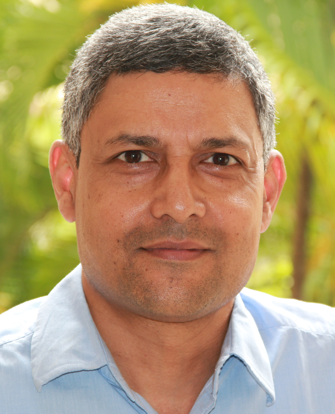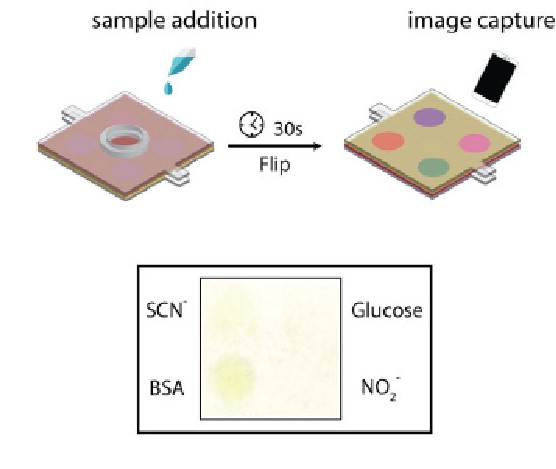 Enhanced water evaporation from A-scale nanoporous graphene
Enhanced water evaporation from A-scale nanoporous graphene
![]() With growing global water stress, there is a pressing need to develop potable water technologies that have a lower carbon footprint.
In a new study, researchers from the Department of Chemical Engineering (CE), IISc and collaborators have developed a novel, low thermal input,
evaporation-based process using single layered graphene sheets synthesised with tunable-sized nanopores.
Enhancing the kinetics of liquid vapor transition from nanoscale confinements is an attractive strategy for developing evaporation and separation applications.
The ultimate confinement limit for evaporation is an atom-thick interface hosting angstrom-scale nanopores.
With growing global water stress, there is a pressing need to develop potable water technologies that have a lower carbon footprint.
In a new study, researchers from the Department of Chemical Engineering (CE), IISc and collaborators have developed a novel, low thermal input,
evaporation-based process using single layered graphene sheets synthesised with tunable-sized nanopores.
Enhancing the kinetics of liquid vapor transition from nanoscale confinements is an attractive strategy for developing evaporation and separation applications.
The ultimate confinement limit for evaporation is an atom-thick interface hosting angstrom-scale nanopores.
Read more ...
 Water flow on defective 2D materials
Water flow on defective 2D materials
![]() Two-dimensional (2D) materials, which consist of a few layers of atoms, are currently being explored for various applications,
including seawater desalination, oil-water separation, and osmotic power harvesting. These materials often contain imperfections
or defects in them, which can alter the properties of the material. Although defects in materials are usually thought to increase
frictional forces, computer simulations show a notably different picture. These unexpected results were published in the
journal Nano Letters by Ananth Govind Rajan, an Assistant Professor in our department, and Aniruddha Seal,
an undergraduate student from the National Institute of Science Education and Research.
Two-dimensional (2D) materials, which consist of a few layers of atoms, are currently being explored for various applications,
including seawater desalination, oil-water separation, and osmotic power harvesting. These materials often contain imperfections
or defects in them, which can alter the properties of the material. Although defects in materials are usually thought to increase
frictional forces, computer simulations show a notably different picture. These unexpected results were published in the
journal Nano Letters by Ananth Govind Rajan, an Assistant Professor in our department, and Aniruddha Seal,
an undergraduate student from the National Institute of Science Education and Research.
Read more ...
 Development of Dengue vaccine tailored to infections in India
Development of Dengue vaccine tailored to infections in India
![]() Dengue virus (DENV) is a mosquito-borne flavivirus with a single-stranded RNA genome that causes an estimated
390 million infections worldwide every year. Although more than a hundred thousand dengue cases are
reported from India every year, the genomic diversity of the prevalent dengue viruses (DENVs) in the country
is largely unknown. Using whole-genome sequencing of viral RNA from clinical human serum samples, Rahul Roy's group
report 119 DENV full-genomes from four metropolitan sites across India from 2012 to 2018. Further, the team of
researchers from NCBS, THSTI and RGCB developed a DENV EDIII-based DNA vaccine by integrating the consensus
sequences from the circulating sequences of each serotype, incorporating the NS1 protein-coding region of DENV2.
Dengue virus (DENV) is a mosquito-borne flavivirus with a single-stranded RNA genome that causes an estimated
390 million infections worldwide every year. Although more than a hundred thousand dengue cases are
reported from India every year, the genomic diversity of the prevalent dengue viruses (DENVs) in the country
is largely unknown. Using whole-genome sequencing of viral RNA from clinical human serum samples, Rahul Roy's group
report 119 DENV full-genomes from four metropolitan sites across India from 2012 to 2018. Further, the team of
researchers from NCBS, THSTI and RGCB developed a DENV EDIII-based DNA vaccine by integrating the consensus
sequences from the circulating sequences of each serotype, incorporating the NS1 protein-coding region of DENV2.
Read more ...
 How crystals nucleate from dilute vapors and solutions?
How crystals nucleate from dilute vapors and solutions?
![]() In chemical process industries, an understanding of the nucleation mechanism is important for design and control of
crystallization processes. Despite numerous computational and experimental studies, its mechanism is not completely
understood. Recent studies have shown that, contrary to century-old classical nucleation theory, crystal nucleation
follows a two-step mechanism where the molecules initially come together to form an aggregate, followed by crystal
nucleation within the aggregate. In such a scenario, Ravi Kumar Reddy Addula and Sudeep N Punnathanam from the
Department of Chemical Engineering have developed a new molecular theory of crystal nucleation
theory from dilute phases such as vapours and dilute solutions.
In chemical process industries, an understanding of the nucleation mechanism is important for design and control of
crystallization processes. Despite numerous computational and experimental studies, its mechanism is not completely
understood. Recent studies have shown that, contrary to century-old classical nucleation theory, crystal nucleation
follows a two-step mechanism where the molecules initially come together to form an aggregate, followed by crystal
nucleation within the aggregate. In such a scenario, Ravi Kumar Reddy Addula and Sudeep N Punnathanam from the
Department of Chemical Engineering have developed a new molecular theory of crystal nucleation
theory from dilute phases such as vapours and dilute solutions.
Read more ...
 Molecular Dynamics simulations of bacterial membranes
Molecular Dynamics simulations of bacterial membranes
![]() Bacteria have complicated membrane architectures that can be composed of an inner phospholipid bilayer, an outer membrane consisting of lipopolysaccharides (LPS) and phospholipids with a peptidoglycan layer consisting of sugars and peptides sandwiched between the outer and the inner layers. This makes is hard to design molecules and drugs that can penetrate the bacteria and eventually kill it. Researchers from the Department of Chemical Engineering and Department of Physics at IISc, in collaboration with Unilever Research and Development, have developed improved laboratory and computer simulation models to understand how antibacterial compounds can penetrate the bacterial membrane and how the peptidoglycan layer works in the bacterial cell. In the future, integration of these systems will enable simulation of molecular models for the entire barrier to entry into the bacteria that can aid in bactericidal drug design.
Bacteria have complicated membrane architectures that can be composed of an inner phospholipid bilayer, an outer membrane consisting of lipopolysaccharides (LPS) and phospholipids with a peptidoglycan layer consisting of sugars and peptides sandwiched between the outer and the inner layers. This makes is hard to design molecules and drugs that can penetrate the bacteria and eventually kill it. Researchers from the Department of Chemical Engineering and Department of Physics at IISc, in collaboration with Unilever Research and Development, have developed improved laboratory and computer simulation models to understand how antibacterial compounds can penetrate the bacterial membrane and how the peptidoglycan layer works in the bacterial cell. In the future, integration of these systems will enable simulation of molecular models for the entire barrier to entry into the bacteria that can aid in bactericidal drug design.
Read more ...
 Predicting the structure of microbial communities
Predicting the structure of microbial communities
![]() Microbial communities are found in nearly every environmental niche, including the soil, the oceans as well as the human body, and are central players in the respective ecosystems. More recently, recognizing their power, artificial microbial communities are being assembled for numerous applications, such as biofuel production. It is important, therefore, to understand how microbial communities thrive and devise new ways of engineering them. In a recent study, Prof. Narendra Dixit together with his M. Tech. student Aamir Ansari developed a new method to efficiently predict the compositions of microbial communities. The study was performed in collaboration with Unilever R&D in Bengaluru. The method, termed EPICS, involves the use of effective pairwise interactions to predict community structures
Microbial communities are found in nearly every environmental niche, including the soil, the oceans as well as the human body, and are central players in the respective ecosystems. More recently, recognizing their power, artificial microbial communities are being assembled for numerous applications, such as biofuel production. It is important, therefore, to understand how microbial communities thrive and devise new ways of engineering them. In a recent study, Prof. Narendra Dixit together with his M. Tech. student Aamir Ansari developed a new method to efficiently predict the compositions of microbial communities. The study was performed in collaboration with Unilever R&D in Bengaluru. The method, termed EPICS, involves the use of effective pairwise interactions to predict community structures
Read more ...
 Understanding COVID19 vaccine efficacies
Understanding COVID19 vaccine efficacies
![]() COVID-19 vaccines have been a game-changer in the current pandemic. Several vaccine candidates have conferred a high degree of protection, with some reducing symptomatic infections by over 95%. What determines this extent of protection remained poorly understood. In a recent study, Narendra Dixit, a professor in our department, together with alumni Pranesh Padmanabhan and Rajat Desikan, developed a mathematical model that predicts how antibodies generated by COVID-19 vaccines confer protection against symptomatic infections. This would help not only understand the workings of COVID-19 vaccines but also optimise their use and speed up the development of new ones.
COVID-19 vaccines have been a game-changer in the current pandemic. Several vaccine candidates have conferred a high degree of protection, with some reducing symptomatic infections by over 95%. What determines this extent of protection remained poorly understood. In a recent study, Narendra Dixit, a professor in our department, together with alumni Pranesh Padmanabhan and Rajat Desikan, developed a mathematical model that predicts how antibodies generated by COVID-19 vaccines confer protection against symptomatic infections. This would help not only understand the workings of COVID-19 vaccines but also optimise their use and speed up the development of new ones.
Read more ...
 Paper diagnostics for anti-microbial resistance detection in urinary tract infections
Paper diagnostics for anti-microbial resistance detection in urinary tract infections
![]() Currently, patients that walk into the doctor's clinic with UTI-like symptoms are often prescribed antibiotics empirically. The standard test that determines the kind of infecting pathogen and its resistance status to various antibiotics takes up to three days to complete. The proposal by Papyrus Pvt Ltd team (a company founded by our faculty, Dr. Bhushan Toley) presented at the C-CAMP AMR Idea Diagnostics Challenge 2022 was the 1st runner-up in this national idea challenge, which saw more than 100 ideas from across the country.
Currently, patients that walk into the doctor's clinic with UTI-like symptoms are often prescribed antibiotics empirically. The standard test that determines the kind of infecting pathogen and its resistance status to various antibiotics takes up to three days to complete. The proposal by Papyrus Pvt Ltd team (a company founded by our faculty, Dr. Bhushan Toley) presented at the C-CAMP AMR Idea Diagnostics Challenge 2022 was the 1st runner-up in this national idea challenge, which saw more than 100 ideas from across the country.
Read more ...

Barrier-Free Microfluidic Paper Analytical Devices
![]() Microfluidic paper analytical devices (μPADs) as low-cost paper devices for conducting multiplexed colorimetric detection of analytes in a fluid. Bhushan Toley's group has developed a new barrier-free design in which multiplex colorimetric detection is accomplished, without having to pattern any barriers in paper. This report published in the journal of Analytical Chemistry can enable the scaling up of fabrication of multiplex colorimetric detection paper-based devices simply by stacking paper membranes in the near future.
Microfluidic paper analytical devices (μPADs) as low-cost paper devices for conducting multiplexed colorimetric detection of analytes in a fluid. Bhushan Toley's group has developed a new barrier-free design in which multiplex colorimetric detection is accomplished, without having to pattern any barriers in paper. This report published in the journal of Analytical Chemistry can enable the scaling up of fabrication of multiplex colorimetric detection paper-based devices simply by stacking paper membranes in the near future.
Read more ...

